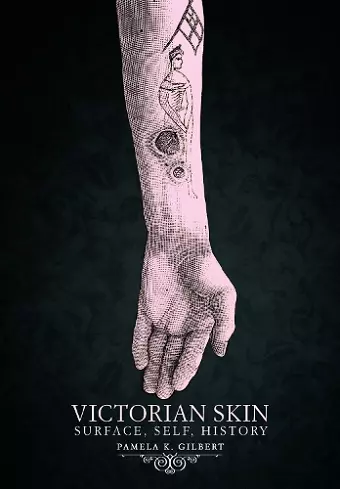Victorian Skin
Surface, Self, History
Format:Hardback
Publisher:Cornell University Press
Published:15th Mar '19
Currently unavailable, and unfortunately no date known when it will be back

In Victorian Skin, Pamela K. Gilbert uses literary, philosophical, medical, and scientific discourses about skin to trace the development of a broader discussion of what it meant to be human in the nineteenth century. Where is subjectivity located? How do we communicate with and understand each other's feelings? How does our surface, which contains us and presents us to others, function and what does it signify?
As Gilbert shows, for Victorians, the skin was a text to be read. Nineteenth-century scientific and philosophical perspectives had reconfigured the purpose and meaning of this organ as more than a wrapping and instead a membrane integral to the generation of the self. Victorian writers embraced this complex perspective on skin even as sanitary writings focused on the surface of the body as a dangerous point of contact between self and others.
Drawing on novels and stories by Dickens, Collins, Hardy, and Wilde, among others, along with their French contemporaries and precursors among the eighteenth-century Scottish thinkers and German idealists, Gilbert examines the understandings and representations of skin in four categories: as a surface for the sensing and expressive self; as a permeable boundary; as an alienable substance; and as the site of inherent and inscribed properties. At the same time, Gilbert connects the ways in which Victorians "read" skin to the way in which Victorian readers (and subsequent literary critics) read works of literature and historical events (especially the French Revolution.) From blushing and flaying to scarring and tattooing, Victorian Skin tracks the fraught relationship between ourselves and our skin.
Gilbert offers abundant information in a framework that moves in and out of philosophical positions on identity, history, and understandings of what being human meant in the 19th century.
* Choice *An invaluable contribution to research that emphatically shows the skin's central role in shaping nineteenth-century debates on the locus of subjectivity, the readability of surfaces, and the relation between the individual body and larger historical narratives.
* Nineteenth-Century Contexts *Victorian Skin draws upon a wealth of literary, scientific and philosophical texts from across the nineteenth century to pursue a richly rewarding discussion on how shifting attitudes towards the body's surface relate to fundamental questions about the boundaries of the self, the inscription of identity and the unfolding of history.... It is interdisciplinary work in literary studies at its best: endlessly curious about the tangled relationship between literature and its contexts, and equally alert to the particularities of both the material bodies and the literary texts it examines.
* Review of English Studies *Drawing from scientific, literary, medical, and political sources, Gilbert shows how skin and its various functions were interpreted over the course of the British nineteenth century.... Besides the richness of her scholarship, Gilbert's analysis of the history and representation of the skin in relation to realism ultimately gives way to texts that treat skin as a detachable signifier. Gilbert juxtaposes original literary readings with medical theory, cultural history, and many accounts that defy categorization.
* Review 19 *This is a book about skin, its discursive side and potential to express interiority in Victorian culture. It is also a tale about the way skin transformed from a text that articulated a so-called surface identity, to a more complex, submerged one.... The volume is largely informed by literary theory... but equally rooted in the most influential historical work on the skin.
* Social History of Medicine *Victorian Skin stands not only as testimony to skin's capacity to organize, if not always to envelop, a vast range of social, cultural, aesthetic, and political functions, but also as an exemplification of the kind of Victorianist historicism for which the field has become best known over the past several decades.
* Nineteenth-Century Literature *An important and unique study of the manifold significances of the skin in Victorian thought... a book of extraordinary intellectual capaciousness.... Gilbert contributes notably to conversations in literature and science and the medical humanities, while also (more briefly) providing new material for scholars of race, empire and (post)colonialism. Victorian Skin is an especially absorbing contribution to the rapidly developing scholarship around the nineteenth century's species politics.
* Journal of Victorian Culture *This book is a great addition to the field, a thought-provoking, wonderfully erudite, and seminal text. I foresee it engendering a plethora of PhD research, studies, articles, and conferences.
* British Association for Victorian Studies *Pamela Gilbert's Victorian Skin: Surface, Self, History is a learned and imaginative work of cultural history and literary criticism... Readers will benefit from this deeply embedded, while also defamiliarized, assessment of the nineteenth century. There is little here that escapes Gilbert's generous and thoughtful attention.
* Journal of British Studies *Victorian Skin focuses our attention compellingly on an aspect of nineteenth-century culture that has long been simultaneously right before our eyes and yet remained largely invisible. Exploring the connections between the cutaneous self and narratives of the historical trajectory helps us see the richly complex significations skin carried throughout the period.
* Dickens Quarterly *Gilbert interweaves literature, Scottish common sense and German idealist philosophy, and physiology's intersection with cognition in her brilliant Victorian Skin.
* Victorian Poetry *Victorian Skin draws upon a wealth of literary, scientific and philosophical texts from across the nineteenth century to pursue a richly rewarding discussion on how shifting attitudes towards the body's surface relate to fundamental questions about the boundaries of the self, the inscription of identity and the unfolding of history. It will be of interest not only to literary scholars of the Victorian period, but also to those engaged more broadly with work on the senses, the emotions, and the medical humanities.
* Review of English Studies *[...]fascinating—and fascinatingly inventive—new book[...]
* Victorians Institute JournISBN: 9781501731594
Dimensions: 229mm x 152mm x 35mm
Weight: 907g
450 pages